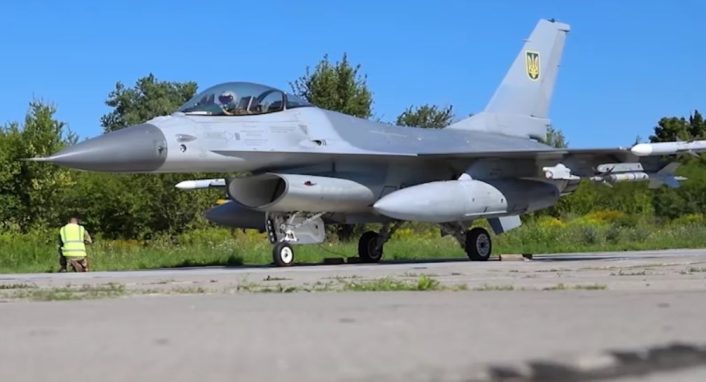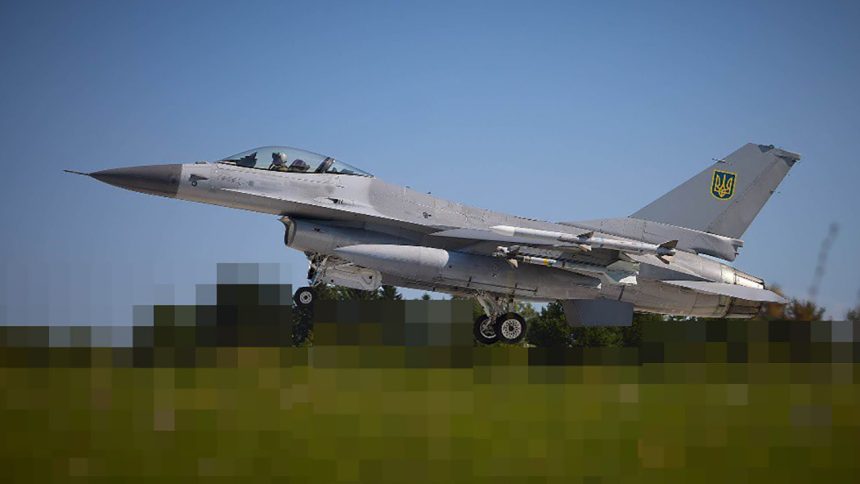First F-16s in Ukrainian Air Force markings break cover.
President Volodymyr has announced that Ukraine has taken delivery of its initial batch of F-16 fighter jets on Aug. 4, 2024. “F-16s are now in Ukraine. We did it,” he proclaimed during a ceremony held at a confidential site, with the aircraft positioned alongside him, and another pair flying overhead. It’s not clear how many aircraft have been delivered so far besides the four seen at the welcome ceremony.
Zelensky mentioned the shortage of trained pilots and jets but remained optimistic, noting that more F-16s and trained personnel are expected soon.
🇺🇦✈️The fist official video of F-16s in Ukraine!https://t.co/E5XTNGSLGE pic.twitter.com/MbSut4JVLL
— Special Kherson Cat 🐈🇺🇦 (@bayraktar_1love) August 4, 2024
Images released by the Ukrainian Air Force depict the fighters armed with live AIM-120 AMRAAM and AIM-9 Sidewinder AAMs (Air-to-Air Missiles) during taxi and flight operations.

Zelensky expressed gratitude towards Denmark, the Netherlands, and especially the United States for their assistance in providing the jets after an 18-month wait, while noting that a significant number of additional jets are still required.
F-16s are in Ukraine 🇺🇦
Welcome to the family! pic.twitter.com/QyOtxQjXpK
— Defense of Ukraine (@DefenceU) August 4, 2024
The arrival of the F-16s, after months of anticipation, represents a significant milestone for Ukraine, although the exact number available and their impact on air defenses and battlefield effectiveness remain uncertain. Russia has targeted potential F-16 bases and vowed to destroy the jets: it’s pretty obvious that Moscow will try its best to destroy the recently delivered jets.
Ukrainian Air Force F-16 making its presence known over the Black Sea city of Odesa. pic.twitter.com/WbTQnEGQsW
— OSINTtechnical (@Osinttechnical) August 4, 2024
Zelensky highlighted the transition to Western combat aviation as a new phase for Ukraine’s air force, achieved through extensive diplomatic efforts. Previously relying on outdated Soviet-era aircraft, Ukraine’s air force has been outmatched by Russia’s superior fleet, enabling Russia to conduct extensive missile strikes and support its eastern frontlines with guided bombs.
Here’s the official statement by President Zelensky:
We are now in a new phase of development for the Air Force of the Armed Forces of Ukraine. We have done a lot to transition the Ukrainian Air Force to a new aviation standard – Western combat aviation. From the beginning of this war, we have been talking with our partners about the need to close the Ukrainian sky from Russian missiles and aircraft. We have held hundreds of meetings and negotiations to strengthen the capabilities of our aviation, air defense, and Defense Forces. We often heard the word “impossible” in response, but we made possible what was our ambition, our defense need, and now – it is a reality in our sky. F-16s in Ukraine. We ensured this. I am proud of all our guys who are skillfully mastering these aircraft and have already started using them for our country. I thank our team for this result. I thank all the partners who are truly helping with the F-16s, and the first countries that accepted our request for aircraft – Denmark, the Netherlands, the United States, – and all our partners, – we value your support. I wish our Air Force and all our warriors to feel the pride of Ukrainians in our combat aviation and to bring Ukraine the combat results that will bring our victory closer – our just peace for Ukraine.
Long preparation
For months, Ukraine has been preparing for the arrival of U.S.-made F-16 fighter jets, which will bolster the Ukrainian Air Force alongside their Soviet-era MiG-29s and Su-27s. The Ukrainian military has said that among these preparations there are measures to protect the new jets from potential Russian attacks while they are on the ground.
The Ukrainian Air Force said it was developing strategies that might involve using underground bunkers and dispersing the aircraft across various airstrips to make it harder for Russian forces to target the F-16s. While the existence of underground airbase facilities in Ukraine is unclear and their construction would be time-consuming, it is likely that the F-16s will be housed in concrete shelters at existing air bases.
To enhance operational flexibility and resilience, the Ukrainian Air Force has long conducted operations from austere airfields, such as highway strips and improvised airfields. These alternative locations are less vulnerable to detection and destruction by enemy forces. Ukrainian pilots have been trained to effectively use these unconventional airstrips, building the skills necessary to take off and land on shorter runways and manage the challenges posed by non-standard facilities. This training has primarily involved aircraft like the Su-25 and Su-27, which are designed for such conditions.
While F-16s can theoretically operate from improvised airfields, including highway strips, certain considerations must be addressed. The surface needs to be solid and clean to prevent damage to the landing gear and other components, as the F-16 is prone to Foreign Object Damage (FOD) due to its large ventral air intake.
Currently, Ukrainian pilots are being trained in the UK, the U.S., Denmark, and Romania, depending on their flying experience. The European F-16 Training Centre (EFTC) at Baza 86 Aeriana Fetesti was established to train Romanian and Ukrainian pilots, as well as other regional F-16 operators, with more than 18 Royal Netherlands Air Force (RNLAF) F-16s, still owned by the Dutch government, available for this purpose.
What the F-16 Can Do for Ukraine
Brigadier General Serhiy Golubtsov, the chief of aviation for the Ukrainian Air Force Command, explained in June what to expect from the Western fighter jet. He noted that while the F-16 is vital for optimizing the performance of Western weapons already delivered to Ukraine, it is not a “panacea” for achieving air superiority. The General cautioned against unrealistic expectations, emphasizing that gaining air superiority with the F-16s alone will be challenging.
Instead, achieving air superiority will require a comprehensive effort, including Electronic Warfare platforms and long-range radar detection aircraft, such as the Swedish ASC 890 Airborne Early Warning aircraft. The versatile, multirole F-16 jets will augment and eventually replace Soviet-era fighters, which have been modified to use Western-donated weapons like the JDAM (Joint Direct Attack Munition), AGM-88 HARM (High-Speed Anti-Radiation Missile), ADM-160 MALD (Miniature Air-Launched Decoy), and the Storm Shadow/SCALP-EG ALCM (Air-Launched Cruise Missile), though these modifications have faced some difficulties.









